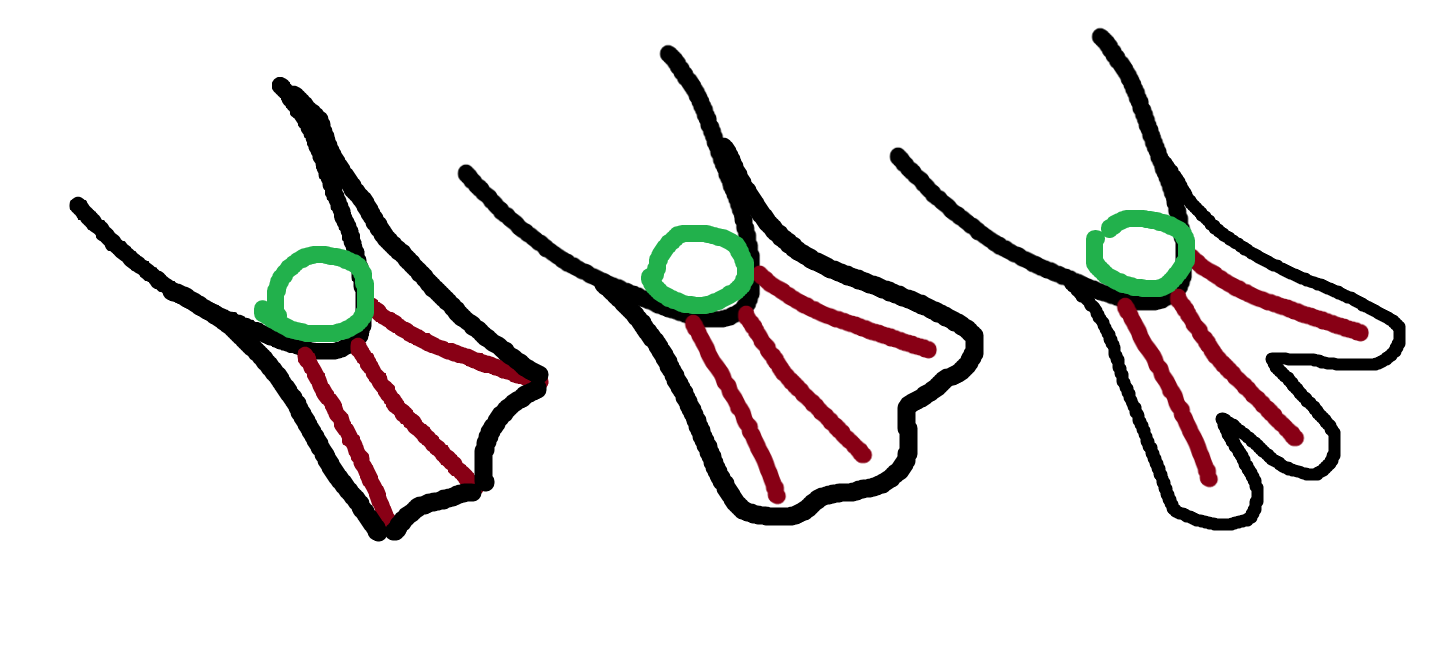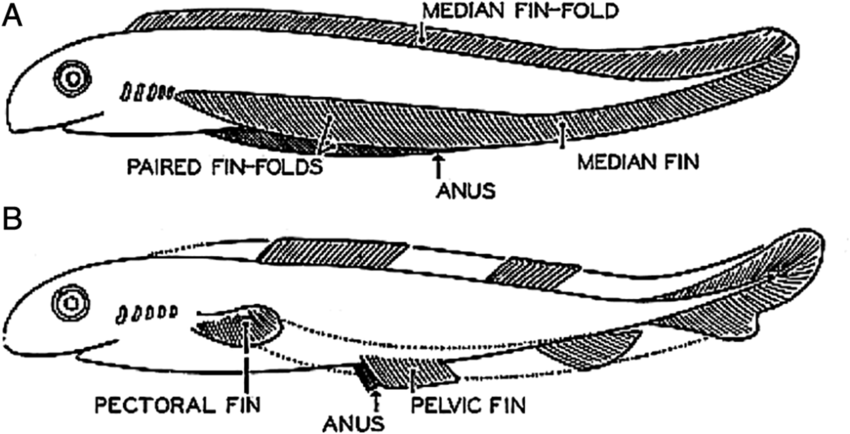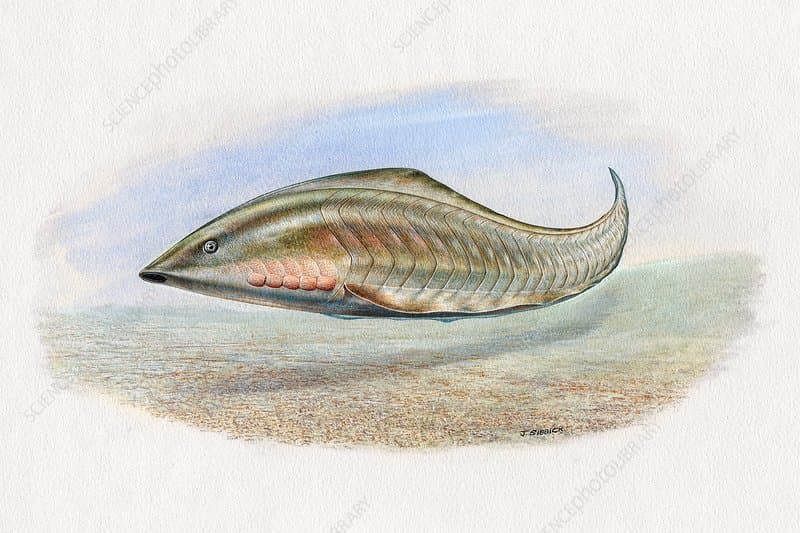EXTREMITIES IN DEPTH
Stats for “Jointed” Extremities
Extremities will be influential in stats, and will be one of the most important ways to gain relevant abilities in the macroscopic stages. Placing a certain type of extremity offers certain abilities to the player, and these abilities have their own baseline stats which are able to be customized. Keep in mind that the shape of the appendage the extremity is attached to will have an extreme effect on stats as well, but this will be discussed more later this post.
I am going to primarily discuss jointed extremities here, because I am more certain about the application of this “appendage-extremity” dynamic to them than the more diverse anatomical structures.
These are the primary stats and abilities which jointed extremities primarily deal with.
- Speed - How fast your organism can move.
- Agility - How good at changing directions and turning your organism is.
- Grasp - How capable of grasping prey or items your organism is.
- Damage - How much damage your organism can apply to another.
Note that stats can be more detailed than this: agility can involve acceleration which is another stat in itself, speed can be altered by the medium through which you are moving, damage can be modified by the defenses of the organism you are trying to attack, etc. But you get the basic idea here.
Extremity/Appendage Interaction with Constraints
Extremities change the nature of the appendage itself, transforming its visual appearance and function. As such, different extremities will make certain appendage shapes more important. We can express this through our constraint system.
- Mass - Appendages with more mass in the distal (farther) regions are typically optimized for striking, while appendages with more mass in the proximal (closer) regions are typically more optimized for movement. Appendages with motile extremities will generally be more massive proximally, while appendages with more offensive extremities will be more massive distally.
- Center of Mass - The appendage itself won’t have a center of mass, but your organism’s overall center of mass will influence the effectiveness of your limbs. I discussed this in an earlier post in this thread more in detail (Macroscopic Editor, Progression, and Principles - #41 by Deus), but organisms with a center of mass closer to their front are generally better at inflicting damage, while organisms with a center of mass closer to their back are generally more motile. So the closer your center of mass is to a given limb, the better its stats will generally be, at the potential cost of stats in another limb.
- Streamline - Certain appendages/extremities will have greater baseline stats, but will also interact very sensitively to streamline measures. This is much more apparent in water or in the air, but on land, this also has repercussions; swift animals tend to have skinny distal regions of their limbs to avoid getting caught on something on the ground. On the other end, organisms which reinforce appendages with weaponry tend to give up some streamline measure.
- I will note that a stat like surface area to volume can be very important to limbs, but I want to hold off on this one a bit until we have a better understanding of other types of extremities. As it relates to motility, appendages with a greater surface area to volume in the water tend to help with floating planktonally while reducing streamline, while more voluminous appendages tend to help with more active propulsion.
Extremity Customization Tools
Appendage Alteration
Remembering that an extremity being placed on a limb transforms that entire limb, one way of altering extremities is by altering the underlying appendage. Appendages will have multiple degrees of customization, including…
- Flattening or fattening for surface-area/volume and motility. Flatter appendages generally maximize surface-area and can increase buoyancy, though being too flat means a reduced streamline measure due to increased drag. Fattening appendages maximized volume and can increase the amount of force put into a limb, potentially assisting propulsion and damage while hampering streamline. Streamline is generally optimized somewhere in the middle, depending on the needs of your organism.
- Adding/reducing metaballs for ideal segmentation. Certain types of extremities function better with a certain number of metaballs. Fins are generally optimized with one or two appendage segments, one for maximal speed and two for additional agility; weight-bearing limbs or weaponry often benefit from atleast two or three segments for additional leverage.
- Increasing/decreasing the size of a segment to alter mass and streamline. Discussed above more in depth (distal v. proximal distribution), but altering the size of a segment alters the distribution of mass in your appendage, as well as how streamline your limb is.
As I mentioned, different customization options for an appendage will alter the stats of the appendage differently; certain extremities could be optimized better by being flatter, while others might be optimized better with more mass on the distal segment of the appendage.
Extremity Manipulation
Extremity customization will differ depending on the extremity itself, and across different skeletal types. In general, customization at first will be limited to appendage customization, but will eventually provide greater layers of detail offered to the extremities themselves.
Because extremities vary so much, I can’t provide an in-depth estimation of every single possibility right now; we can think of extremity customization as a macroscopic proxy of the “Modify” tool in the Microscopic Stages, so things vary. There are some things I do want to bring up, however, particularly related to the most relevant extremities.
Digits!
Representing fin spicules, fingers, toes, paws, and more, digits will be the primary way for endoskeletal organisms to customize their extremity itself. The first extremities available to the player won’t have digits, but when a dermal endoskeleton evolves, digits can be utilized.
Digits will alter stats and function of extremities. They will allow the player control over shape, which in turn strongly alters the importance of certain constraints. They can also combine multiple abilities into one appendage (lob fins that can bear weight and swim, hands that can strike and grab, etc.). Digits behave differently across different extremity types, so alteration of digit structure will be common; longer digits are useful for graspers, while more spread out digits are useful for ray fins.
Digits will remain as you switch across different types of extremities. If you switch out your lobbed fins with three digits for a ray fin, those three digits become three fin rays in the ray fin; if you switch that lobbed fin for a foot, those three digits become three toes; if you switch that foot into a wing, those digits become the finger guides for your wing. So on and so on.
If it is possible, the actual mechanism through which digits are added can be one of the more free-form segments of sculpting in the editor. Players can add a digit, then drag, tweak, and angle that digit as they please. If that proves to be immensely challenging, then we can parametrize as needed; adding a given number of digits via a more simple button, and allowing variations akin to modifications.

A bootleg concept of how digits can transfer between different types of extremities: from left to right, ray fins, lobed fins, and feet. Green indicates the metaball end of the appendage, while red indicates the digits themselves. Note that the underlying shape remains the same across the different extremity types. The only difference is the black outline, indicating a change of form.
Tail Customization
I think the important thing when it comes to tail customization is most relevant for the aquatic portion of the Macroscopic Stage. Digit customization for the tail can essentially be how you shape your tail fin. This provides a pretty intuitive way to represent different tail fin structures, and can represent more nuanced adaptations, like rotating digits resulting in a paddle that is oriented to flap up-and-down (like in cetaceans).

The concept above shows a pretty basic fin shape. The crimson red outline indicates the form of the extremity, while the lighter red/orange lines inside the tail fin indicates two digits angled in a way to give that fin shape. This gives a pretty easy method of customization. There’s a lot of function underlying tail fin shapes, but that’s beyond the point for right now; we can get into that once we have some common understanding of the underlying mechanics.
What gives me some pause for thought is how to deal with the more paddle-like fins and fin folds seen in primitive fish, such as the ones below:

For the bottom one, with the more defined paddle fin, that could be dealt with digit manipulation if customization works smoothly:

Top body plan indicates an animal with a fin extremity on their end without digits, and the bottom one with digits. Crimson and orange color scheme is the same as the prior concept, but this time, the green line indicates where the tail joint starts.
So with those basal fin folds - applying that specific extremity to your tail applies that fin to the entire length of your tail without digits, and digits can further customize the shape of your fin. Some general “sharpness” mechanic can also provide a general definition on your tail shape, whether or not it forms an explicitly fin or if it’s more of a fold. This can be a nice progression and introduction to more advanced digit manipulation of tails that comes with more advanced morphological structures.
Beyond that, I think we should note that the tail will require a bit more specific handling than other extremities, just for the fact that you can’t apply certain things on a tail (an “ear” extremity, for example, doesn’t make sense on a tail). The weaponry and tools we offer to the tail appendage generally shouldn’t be the same menu offered to other, non-torso appendage.
I will link this page for future reference: Fish locomotion - Wikipedia
Auto-Evo Consideration
I think an important thing to ask is how auto-evo will, one, understand what it is doing, and two, create organisms that don’t look like blobs. I think of this more specifically when it comes to the manipulation of extremities, such as digits, tails, etc.
I think presenting our edits via shape guides from a prior concept, where players are able to tweak their extremities via accessible sliders, are a good thing to build our extremities around. Players can drag sliders and such in a way that easily adjusts the shape, which in theory should make such manipulation a bit easier for auto-evo to tweak; auto-evo places those shapes, and tweaks them in certain ways to maximize certain stats.
Of course, I’d appreciate any feedback on what exactly auto-evo can and can’t “think through”. I think we can get away with some broader customization tools for torsos, appendages, and mouths while still representing an extreme amount of customization and depth - its extremities where more in-depth tweaking is seen, and where that level of customization would probably be requested by the playerbase.
Endoskeletal v. Exoskeletal Customization
There will be differences in how customization works between organisms with an exoskeleton and organisms with an endoskeleton which proximate the differences in body plan evolution between the two.
Endoskeletal organisms will generally have more fine-tuned customization over their limb-related parts - for example, digits. Arthropods won’t have a customization tool such as digits, but will generally have much greater ease in customizing the appendage itself, and will generally have more diverse extremity types they can place on their appendage.
I can see customization options for, say, pinching claws that can mirror digits in vertebrates, but that involves less the dynamic addition of parts and more the tweaking of the underlying shape of the two ends of the claw.
I want to handle arthropod customization with its own post, so I will share more detail on that later. The mechanics should generally be the same once everything is established, just with some smaller tweaks and different visuals.
Catalogue
Fins
Players will first be able to manipulate basic stats about their organism, such as streamline measure, mass, and center of gravity via extremity-less appendages to adjust their fluid dynamics. Controls such as flattening or fattening an appendage, increasing/decreasing its size, and manipulating length will adjust these constraints, loosely influencing movement.
Once their skeleton becomes proficiently advanced, players will be able to place fins on their appendages. Fins will strongly boost player movement based on constraints - for example, a streamlined appendage will provide much more of a movement bonus once that appendage becomes a fin.
Certain fins respond better to certain constraints - for example, ray fins respond extremely sensitively to streamline measures and surface area, but suffer more of a penalty from being on massive appendages, while lobbed fins behave the opposite way. As such, different fins will require different limb shapes to perform optimally.
- Cartilagenous Fin - The first available fin for vertebrates, cartilaginous fins are generally well-rounded, responding in a balanced measure towards most of the constraints. Cartilagenous fins provide solid versatility, but due to their limited flexion and control compared to other fins, provide less extreme stat bonuses.
- Lobe Fins - Needed for transitioning to land, lobe fins evolve from cartilaginous fins. Lobe finned organisms suffer much less of a performance reduction from mass, making it an ideal choice for larger primitive fish who don’t yet have an optimized body plan and armored fish. Lobe fins allow some basic movement on land and perform well in shallow and benthic lifestyles, making them the ideal choice for animals living in shallower waters who seek to transition to land. They have less response to being streamlined, meaning organisms with lobbed fins, unless very well-built, will be less nimble than ray finned or faster cartilaginous organisms.
- Ray Fins - Evolving from lobed fins, ray fins are generally the best optimized fins for organisms which choose to stay in the oceans. Except at extreme sizes or in massive organisms, ray-finned marine life will enjoy peak movement in the water. Ray fins are extremely optimized towards being streamline, and also respond very well to surface area, making them well-suited for organisms that enjoy speed or drifting.
Weapons
Players will be able to place certain defensive or offensive capabilities on their appendages, turning that entire appendage into a weapon. Many of these structures will respond extremely well to mass, but the dimensions of the appendage can also be influential and can benefit customization.
A majority of players will likely utilize their mouth as their primary weapons, but can diversify their options via appendages.
- Spike - Indicating the placement of a stiff spike, this turns the appendage into an extremity which inflicts damage upon contact. Benefits heavily from mass, but has a notable effect on center of gravity and streamline measures. The speed at which contact is made scales damage, as well as the dimensions of the spike; longer spikes are able to inflict damage at a wider area, but apply less damage. Are generally more defensive than stingers, indicating a constant potential for damage, but can be leveraged offensively with speed or creative body plans. This requires a skeleton to place down.
- Cnidoblast - Indicating the placement of cnidoblasts on the surface of an appendage, this extremity can inflict an extreme amount of agents upon contact. Available very early on in the Macroscopic Stage, the effect scales with surface area. Cnidoblasts can be placed on appendages with joints, but unlike stingers, they do not apply base damage and only apply the effect. Alterations to this extremity can enable a temporary grappling of any organisms which come in contact with the appendage.
- Stingers - Indicating the placement of barbs, this turns the appendage into a weapon able to jab at other organisms, like in stingrays, scorpions, and other arthropods. As opposed to cnidoblasts and spikes, allows an offensive “strike” ability which applies base damage, enabling an intentional leverage of weaponry. Can be altered to include agent damage. More mass indicates more baseline damage, though it also slows down the speed at which the strike happens. Stingers require a jointed appendage to place down. Longer appendages generally attack more slowly, but have a wider reach and can enable more mass to be put into the appendage.
Utility
Other appendages can just generally influence constraints, add different uses and abilities, or provide alternative movement methods. This is sort of a catch all for now, but with further conceptualization, more clear patterns can emerge.
- Sensory Antennae - Proximating a whisker or antenna, placing this extremity on an appendage turns it into a wispy and skinny rod focused primarily on sense. Exactly how senses will work is a topic for another day, but I think something we can guess is that the antennae are extremely responsive to surface area, improving sensory capabilities with increased surface area but also strongly impacting health and tolerances.
- Ears - Available after a certain point, a certain time of extremity allows the attachment of ears to an appendage, transforming that appendage into an ear similar to those found on mammals. Before then, serve as simple parts, able to be placed on an organism freely. Heavily respondent to surface area.
- Filter-Feeding Surface - Proximating a very think area of the body, applying this extremity will transform the entire appendage into one capable of gaseous exchange and absorption of nutrition, such as in jellyfish and certain ecdysozoans. Heavily influenced by surface area, this extremity is extremely useful if the player has an integument that inherently has a high responsiveness to surface area, but is less useful for organisms with thicker/less-sensitive skins.
I think for now, that’s all I’ll list. The list of extremities can obviously go on forever, and I do think we should have a good amount more. But my point is that even with these few options, we can create really interesting gameplay if we tie them into constraints. And also just illustrating how the concept can work with different types of extremities.
What’s Next
Looking through existing posts, I think we are reaching a very solid point for a concept on the macroscopic external editor. I’m not saying this is an absolute commitment right now, but I do think it is the most robust and comprehensive take on a potential Macroscopic Editor, with decent mechanics to encourage robust gameplay and creativity.
I think my next step will be a concept focused specifically on how editing an organism with an exoskeleton will differ. Again, as I mentioned above, it shouldn’t be that different from the editor as a whole, I think I just need to flesh out the catalogue and do some more research to ensure that what has currently been written is consistent with arthropod evolution.
Then, I’m going to focus a bit on the internal, organ system editor. The thing with that is that the internal editor is heavily correspondent with progression in the stage, so I will need to flesh out expected experiences for macroscopic gameplay as a whole and general progression mechanics.
The Skeletal System I think is the most easy organ system to think of through since it is so relevant to the External Editor (integument, appendages, and jaws), but Sensory and Respiratory Systems are also important since it will clarify a bit more about the type of extremities we offer (things like ears, gills, antennae, etc. being individual parts, or extremities).
Beyond that, I appreciate all feedback on these concepts. I am obviously looking for input from programming and the graphics team on how feasible aspects of this concept are, but would also appreciate input from those working on Auto-Evo as to whether or not certain aspects of these concepts might be too much for the algorithm to handle.
Regardless, the Macroscopic Editor is nowhere close to being “solved”, but I think this is a solid spot to be in. I think some baseline ideas, like the constraints and torso editing, can be prototyped at this point.


